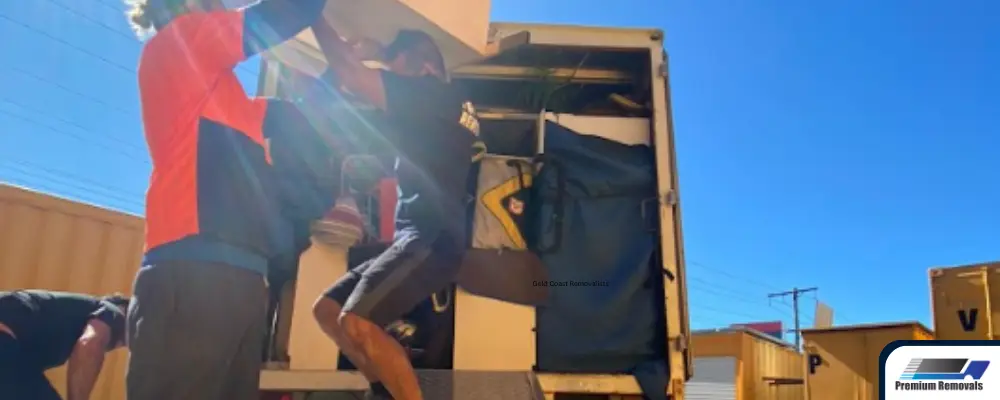Key Highlights
Shifting heavy furniture down stairs can be quite the task, especially when you’re on your own. But don’t worry, it’s definitely doable with some know-how and the right gear. In this blog post, we’ll walk you through how to easily move heavy items by yourself without hurting yourself or damaging your stuff. We’ll cover everything from how to lift properly to why it’s crucial to have tools like a hand truck or furniture dollies at hand, and give you tips on keeping safe while doing so.
- Make sure proper lifting techniques are part of your plan to prevent injuries.
- Think about using a hand truck or furniture dollies; they really help in making the moving process smoother.
- Before trying to move anything, take a moment to check its weight and size.
- Ensure there’s nothing in your way and safeguard the staircase against potential mishaps.
- Keep things secure by fastening loose parts and wrapping up your belongings for protection during their journey downstairs.
- -With every step taken down those stairs adjust how you’re holding onto things carefully maintaining grip strength balance.

Introduction
Shifting heavy furniture down stairs by yourself might seem tough, but with the correct approach, tools, and proper lifting techniques, you can do it smoothly. It’s handy to know how to safely and efficiently move heavy items whether you’re changing things up in your current home or heading to a new place.
With moving heavy furniture on your own, using the right way to lift is super important. If you don’t lift these bulky pieces correctly, you could end up hurting yourself badly—like pulling a muscle or worse. Plus, dealing with big and awkwardly shaped furniture makes this task even trickier because of tight spaces like staircases.
In our blog post today we’ll walk through how to tackle moving heavy furniture downstairs without any help. From getting ready for the move all the way through picking out suitable equipment and applying those crucial proper lifting techniques; we’ve got it covered! Stick with us for tips that will make sure your solo move goes off without a hitch.
Preparing to Move Heavy Furniture Alone
Before you start taking heavy furniture down the stairs by yourself, it’s really important to get ready for what’s ahead. Getting prepared can make sure everything goes smoothly and safely.
With that in mind, one of your first steps should be to figure out how big and heavy the pieces of furniture are that you’re going to move. Knowing this helps you understand just how tough moving them might be, and whether or not you’ll need some extra hands or tools. On top of that, making sure there’s nothing in your way is key. Clearing any obstacles from your path will help avoid any hiccups during the move.
Also, think about using furniture pads as they can save both your staircase and furniture from getting scratched up or damaged. These pads work great because they reduce friction when sliding heavy objects across surfaces which is super helpful for preventing scratches or other damage while moving process unfolds with those heavy items.

Understanding the Challenges of Moving Heavy Items Downstairs
When you’re trying to move heavy items down stairs by yourself, there are a few tricky parts you’ve got to think about. For starters, dealing with the flight of stairs can be tough. They might be narrow or steep and don’t leave much room for moving big and bulky furniture around.
With heavy lifting, it’s really important not to hurt yourself. You have to know how to lift things the right way, using your legs so your back doesn’t take all the strain when handling heavy objects.
Then there’s navigating through tight spaces like doorways and hallways that aren’t very forgiving if what you’re moving is large. Planning ahead by measuring both your furniture and those spots in advance can make this part easier.
Knowing these hurdles well means you’ll be better set up for figuring out how best to tackle them when shifting heavy items downstairs on your own.
Gathering Necessary Equipment and Resources
When you’re dealing with the challenge of moving heavy furniture downstairs by yourself, having the right gear and resources is key. This stuff not only makes your job easier but also keeps things safe.
For starters, a hand truck or a furniture dolly is super important. With wheels and a platform, these tools help carry those bulky items without much trouble. They take off some of the load from your shoulders so you can move things smoothly. If we’re talking about really big stuff like appliances, an appliance dolly comes in handy for that too.
Then there are furniture sliders which are pretty neat for dragging heavy pieces down stairs. You just slip them under the legs of your furniture and voila! It slides more easily because they cut down on friction between your precious cargo and steps, keeping both free from scratches or any harm.
So by rounding up all this equipment before starting to move heavy items alone downstairs ensures everything goes way smoother during the moving process.

A Comprehensive Beginner’s Guide to Moving Heavy Furniture Alone
Shifting big, heavy furniture by yourself might sound super tough, but if you know the right way to do it, you’ll get through it just fine. This guide is like a beginner’s handbook that walks you through every step and gives you helpful advice to make moving stuff downstairs on your own easier and less risky.
We’re going to talk about how to figure out how much your furniture weighs and its size before we move on to showing you the correct way to lift it. With tips on why wearing sturdy shoes matters and keeping a tight hold of whatever you’re carrying, this guide has got all bases covered. Stick with these instructions, use proper lifting techniques for heavy furniture with a firm grip while sporting the right footwear, and moving hefty items solo will seem like no big deal at all.
Step 1: Assessing the Weight and Dimensions of Your Furniture
When you’re getting ready to move heavy furniture downstairs by yourself, the first thing you should do is figure out how big and heavy it is. This helps you understand if the job’s going to be tough and whether or not you’ll need extra hands or tools.
With a tape measure in hand, check how tall, wide, and deep your furniture is. For pieces that aren’t shaped normally, just make sure to record the longest and widest parts. Don’t forget to measure doorways, hallways, and any other narrow spots your furniture has to go through.
Making sure there’s enough space for your stuff to fit without trouble is key. If something’s too bulky or hefty for the path ahead of it might be smart thinking about taking it apart or picking another way around.
By looking into how much space there really is available compared with what’s needed for moving process including tight spaces can help plan better ensuring smooth sailing when shifting those weighty items.
Step 2: Clearing the Path and Protecting the Staircase
Before you tackle the task of taking heavy furniture down the stairs by yourself, it’s really important to make sure your way is clear and that your staircase is shielded. Doing this can keep both your furniture and stairs safe from harm.
Start with getting rid of anything in the way like rugs, clutter, or those handy furniture pads. This makes a clean path for you to move stuff without trouble.
For keeping your staircase scratch-free, lay down some cardboard boxes or use more of those protective furniture pads on each step. And don’t forget about watching out for door frames and other spots that might get banged up if not covered properly.
With everything cleared out and protected well, moving heavy items should go smoothly without any mishaps.
Step 3: Securing Loose Parts and Wrapping the Furniture
When you’re getting ready to take heavy furniture down the stairs by yourself, make sure all the bits that can come off are secured and that you’ve wrapped everything up well. Doing this helps keep your furniture safe from harm and makes moving it a lot easier.
Here’s how to do it right:
- Take out any parts of the furniture that can be removed, like drawers or shelves, and pack them up separately.
- For protecting against scratches and dents, bubble wrap or furniture pads work great on sharp corners and edges.
- To hold all the protective stuff in place—and add another layer of safety—wrap plastic around your pieces.
By taking care with removable parts and using things like bubble wrap or furniture pads during the moving process, you lower chances of damage. This way, your heavy items stay looking good as new.
Step 4: Choosing the Right Moving Equipment
When it comes to moving heavy furniture by yourself, especially down the stairs, picking out the right tools is key. These tools not only make your job easier and more efficient but also a lot safer.
For starters, think about using a hand truck or furniture dollies. With their wheels and sturdy platform, they’re perfect for bearing the weight of your heavy items. This way, you won’t have to put too much strain on yourself while still being able to move everything smoothly and with good control.
Another handy item is a lifting strap. This gadget works wonders in spreading out the weight evenly so that lifting and shifting around becomes less of a chore. Plus, it gives you better leverage which means less stress on both your back and arms.
So by choosing these right pieces of equipment – like hand trucks,dollies,and straps- tackling those bulky pieces alone can turn into a manageable task.
Step 5: Utilizing Proper Lifting Techniques to Prevent Injury
When you’re moving heavy furniture downstairs by yourself, it’s really important to lift things the right way. Doing this helps stop you from getting hurt and makes sure everything goes smoothly.
Here are some tips on how to do it properly:
- When picking up something heavy, bend your knees and use the strength in your legs instead of making your back do all the work.
- Keep a tight hold on whatever you’re carrying and keep it close to you. This helps with keeping things steady.
- Try not to twist around while holding heavy stuff because that can mess up your back and lead to injuries.
By sticking with these proper lifting techniques, you’ll lower the chance of hurting yourself when moving big pieces like furniture down stairs alone.
Step 6: Maneuvering Furniture Down the Stairs
Moving heavy furniture down the stairs needs a good plan and careful steps. Here’s how you can do it safely:
- When the furniture is too big or heavy, think about using a hand dolly or furniture dollies. These have wheels which help in moving the stuff easier down steps.
- Keep your feet apart as wide as your shoulders to stay steady, and make sure your back stays straight.
- Take it one step at a time when lowering the piece of furniture, making sure you’re holding on tight and keeping everything under control.
By sticking to these pointers, you’ll be able to get that bulky item downstairs without hurting yourself or causing any damage.
Step 7: Adjusting Your Grip and Balance as You Descend
When you’re moving heavy furniture down the stairs, it’s really important to hold on tight and keep your balance so everything goes smoothly. Here are a few tips that can help:
- Make sure to wear shoes that won’t slip because you don’t want to fall.
- Keep a strong hold on the furniture and pull it close to your body. This helps you control it better and stay balanced.
- As you go down each step, change how you’re standing if needed so that you don’t trip or drop anything.
By making sure your grip is solid and keeping yourself steady, moving heavy furniture by yourself becomes safer for both you and the piece of furniture.
Safety Tips for Moving Heavy Furniture Alone
When you’re taking on the task of moving heavy furniture downstairs by yourself, making sure you stay safe is super important. Here’s what to keep in mind:
- Before anything else, make sure you’ve got the right gear like gloves and solid shoes to avoid getting hurt.
- When picking up something heavy, do it the right way so your back doesn’t get messed up or pull a muscle.
- Go slow and steady. If you need a breather, take one. Always be aware of what’s around you.
Sticking to these safety tips can really help cut down on accidents or injuries when dealing with heavy furniture all alone.
Importance of Wearing Protective Gear
When you’re moving heavy furniture by yourself, especially down the stairs, it’s really important to wear the right protective gear. Here’s why:
- With proper shoes that have good grip, you can avoid slipping and falling. This is super helpful when you’re going up or down stairs or walking on floors that might be a bit slick.
- Gloves help you hold onto your furniture better so there’s less chance of dropping something or losing your grip.
- Wearing things like knee pads or back braces gives extra support and keeps you safe while lifting those heavy items.
By putting on this kind of gear, not only do you cut down on getting hurt but also make sure moving stuff goes more smoothly.

How to Maintain Stability and Avoid Falls
When you’re lugging heavy furniture down stairs by yourself, it’s super important to stay steady and not fall. This keeps both you and your stuff safe. Here are some pointers for keeping balanced while moving:
- By standing with your feet apart as wide as your shoulders, you create a stable base. It makes holding the weight easier because it spreads out more evenly.
- When picking up things, bend at the knees and keep that back straight to avoid hurting yourself. Don’t twist around; instead, make sure your middle section is tight to help with balance.
- Move slowly and carefully without any sudden jerks that could make you lose control or hurt yourself from rushing too much.
- If tiredness kicks in, don’t hesitate to pause for a bit of rest before continuing on again so accidents can be avoided due to overexertion.
- Wearing shoes that won’t slip easily helps prevent falls; also ensure there’s nothing in the way where someone might trip.
By sticking with these suggestions during the moving process of heavy furniture alone downstairs ensures not only safety but also success in getting everything moved properly using proper lifting techniques without damaging belongings or causing harm due its stability throughout each step taken towards completion
Advanced Techniques for Moving Extremely Heavy Items
When you’re trying to move really heavy stuff by yourself, it can be pretty tough. But there are some cool tricks that make the job a lot easier and quicker. Here’s how you can handle moving big things without too much trouble:
- With sliders: These little pads go under the legs of your furniture and help it glide across floors like hardwood with less rubbing, making it way simpler to push around.
- By using ramps: If you’ve got stairs to deal with, laying down plywood boards as ramps lets you slide those bulky items down instead of having to lift them. It saves your back a ton of strain.
- Through employing plywood: Plywood is super handy not just for ramps but also as a temporary floor over your actual one when shifting large pieces around. It keeps both your home’s floors and the bottom of your furniture safe from scratches or tears.
Tapping into these methods when moving heavy objects or furniture onto hardwood floors or through tight spots means less sweat for you and protection against damage all round.
Using Sliders and Glides for Smoother Movement
When you’re dealing with moving heavy furniture, throwing in some sliders and glides can really change the game by making things a lot easier to move. Think of sliders as little pads or disks that cut down on the friction between your furniture and the floor, so you don’t have to work as hard to push it around. Here’s a quick guide on how to use these handy tools for an easier time:
- For starters, pop those sliders right under the legs or corners of whatever piece of furniture you’re trying to move. Make sure they’re spread out nicely so everything stays balanced.
- These gadgets are super helpful when you’ve got heavy stuff to shift across hardwood floors or any other slick surface where dragging things usually feels like a workout.
- The whole point is they take away some of that friction so pushing heavy items doesn’t feel like such a big deal anymore. This means less huffing and puffing for you and makes getting through your moving process way smoother.
Just make sure when picking out sliders; they match up well with what your furniture weighs and its size. You want them snugly attached offering solid support all round. Sliders not only help ease up shifting weighty pieces especially over surfaces like hardwood floors but also keep both your floor and furnishings from getting banged up during the shuffle.
Leveraging Ramps to Ease the Descent
Taking heavy stuff down the stairs can really be tough, especially if you’re on your own. But, by using ramps, you can make this job a lot easier and safer. Here’s a step-by-step guide to help with moving heavy furniture downstairs:
- With sturdy plywood boards, build a ramp that matches the size of your furniture in width and length.
- To keep it from moving around while you work, fasten the ramp securely to the stairs with clamps or something similar.
- Place your furniture carefully at the top of this setup to make sure it won’t tip over.
- Gently let it slide down the ramp. It’s important to go slow here and stay in control so nothing goes wrong.
- At the bottom of those stairs, double-check there’s nothing in way that could trip someone.
By taking advantage of ramps for moving heavy objects like furniture, not only does everything become smoother but also less risky for both people involved and their surroundings. Plus, it helps avoid hurting yourself or messing up either what you’re carrying or where you’re going through
When to Seek Professional Help
Moving heavy furniture by yourself can feel rewarding, but sometimes it’s smarter to get help from a professional mover. Here are a few reasons why:
- For tricky jobs: When dealing with big or fragile pieces that need special care, movers know exactly what to do and have the right tools for the job.
- With no moving truck: If you don’t have a good vehicle for moving your stuff, professional movers will make sure everything gets where it needs to go safely.
- When time or resources are tight: Professional movers can take over the whole moving process if you’re short on time or help, making things less stressful.
Movers are skilled at transporting both bulky and delicate items without damage. It might be worth getting in touch with a professional mover when faced with complicated tasks or if organizing the move feels overwhelming.

Identifying Situations Beyond Personal Capability
Knowing when you’re out of your depth with moving heavy furniture is key. Here’s how to tell it might be time to call in a professional mover:
- With large items that are too big or awkward for one person, movers have the right tools and enough hands to safely move them.
- When it comes to heavy lifting, if you doubt your strength or know-how on using proper lifting techniques without getting hurt, professionals should take over.
- Without friends or family around to lend a hand, trying to shift heavy objects by yourself isn’t wise.
Understanding when you need help from someone skilled can make relocating not just easier but safer too.
Benefits of Hiring Professional Movers for Complex Tasks
When you bring in professional movers to tackle the tough jobs, it’s not just about shifting heavy furniture. Here are some perks of getting pros on board for those tricky moves:
- With their know-how, these movers make sure your stuff gets from point A to B safely and smoothly.
- They come equipped with tools like dollies and padding that help move your belongings without a hitch, even through tight spots.
- By letting them handle the grunt work, you get more time on your hands for things like hooking up utilities or getting your new place sorted.
- Sometimes you might need a spot to keep your things temporarily. Many moving companies can help out with storage solutions too.
Choosing professional movers means leaning on their experience during the moving process so everything goes off without a snag. You save precious time and energy while ensuring all your belongings arrive intact at their destination.
After the Move: Ensuring Everything Is in Place
After you’ve managed to move your heavy furniture down the stairs by yourself, there are a couple of key things you should do to make sure everything’s just right in your new place. Here’s what to keep in mind once you’re settled:
- Furniture setup: Spend some time getting your furniture exactly where you want it in your new home. Make sure each piece is placed safely and looks good.
- Post-move assessment: Look over all of your pieces for any damage or wear that might have happened during the move. It’s important so you can fix anything that needs attention quickly.
- Familiarize yourself with the new place: Walk around and get to know every corner of where you now live. Understanding how each room connects will help a lot when deciding where all your stuff goes, making this space feel like yours.
Taking care of these steps after moving ensures that not only is your heavy furniture set up well but also helps turn this new location into a cozy spot for yourself.
Final Adjustments and Furniture Setup
After you’ve managed to move heavy furniture down stairs by yourself and have gotten to your new place, it’s crucial to get the final touches and setup right so it feels like home. Here are some pointers on how to do that:
- Start with measuring: Before anything else, measure each room’s size so you know your furniture will fit just right. When planning where everything goes, think about things like sunlight coming in and how people will walk around.
- Look for flat surfaces: Make sure all your pieces sit on flat ground. This keeps them steady and stops any wobbling or tipping over.
- Keep heavy items secure: If earthquakes are common where you live or if kids run around your house, attach big pieces of furniture firmly to the walls using brackets or anchors.
- Be open to changes: Once you’re settled in a bit more, you might see that some setups work better than others for either looks or use. Don’t hesitate to switch things up.
By sticking with these suggestions after moving heavy furniture into a new place, ensuring they rest on flat surfaces, among other tips mentioned above can help make settling into your new spot smoother and safer
Conducting a Post-Move Assessment for Damage
After you’ve managed to move heavy furniture down the stairs by yourself, it’s smart to do a check-up afterwards to see if anything got damaged. Here’s what you should look at:
- Look over each piece of furniture for dents, scratches, or any other damage. Pay extra attention to corners and edges that might have bumped into walls or something else.
- With every bump or weird shape on your furniture, think about whether it could mean there’s some hidden damage inside.
- See if any screws, hinges, or bits and pieces are loose or missing; these might need fixing up.
- Write down any problems you spot and take pictures too. This can really help with insurance claims or when calling in someone professional for repairs.
Doing this kind of assessment after moving helps catch any issues early so you can sort them out quickly.
Conclusion
Taking on the challenge of moving heavy furniture down stairs by yourself might seem tough, but if you get ready properly and use the right methods, it’s definitely doable in a safe and effective way. First off, figure out how much your furniture weighs. Then make sure there’s nothing in your way that could trip you up or cause problems. It’s also important to tie down anything on the furniture that could swing around or come loose. When it comes to actually lifting and carrying stuff, knowing how to do it correctly is key so you don’t end up hurting yourself. Wearing safety gear can help keep accidents at bay too.
If all this sounds like a bit too much for one person to handle alone, asking experts for help isn’t something you should shy away from doing.
After everything has been moved into place carefully check over each item just in case they got banged up or scratched during the move.
Whether this is your first time trying something like this or if you’re after some more advanced tips,
these steps are here to guide anyone through making their move as smooth as possible.
And remember we’re always here ready
to lend a hand whenever needed
Frequently Asked Questions
What Are the Best Tools for Moving Heavy Furniture Alone?
When you’re moving heavy furniture by yourself, a few tools can really make the job easier. With things like a hand truck or dolly, furniture dollies, lifting straps, and sliders at your disposal, you won’t have to put as much strain on your body. These items are great for making the whole moving process more efficient and less of a hassle.
How Can I Protect My Back While Moving Heavy Items?
When you’re moving heavy items, it’s really important to keep your back safe. To do this, make sure you bend your knees and keep your back straight while lifting. Also, using a strap can be a big help because it spreads out the weight and supports your back.
Is It Possible to Move Heavy Furniture Upstairs Alone?
Moving heavy furniture by yourself, especially up the stairs, might seem tough. However, with the right tools like ramps and a hand truck at your disposal, along with knowing how to lift properly, you can definitely make it easier on yourself.
What Should I Do If I Encounter an Obstacle While Moving Furniture Downstairs?
When you’re moving furniture downstairs and run into something in the way, make sure to keep both your furniture and whatever you bumped into safe. You can do this by putting furniture pads or cardboard around them so they don’t get scratched up. Be careful as you go around the obstacle, taking it slow to avoid any damage.
Can I Disassemble All Types of Furniture Before Moving Them?
Sure, taking apart different kinds of furniture before you move them is a good idea. It helps by making things lighter and smaller. Just make sure you’ve got the right tools on hand and remember where all the screws and bits go so you can put everything back together afterwards.
How Do I Decide Whether to Move Heavy Furniture Myself or Hire Professionals?
When it comes to shifting heavy furniture, you’ve got two choices: do it yourself or get the pros. If you’re strong enough, know how to lift correctly, and have the right tools at hand, then moving stuff on your own might work out. But for really bulky items or situations where tricky moves are needed, bringing in professional movers is a smarter move. They’ve got both the experience and equipment necessary to make sure everything goes smoothly and safely.
